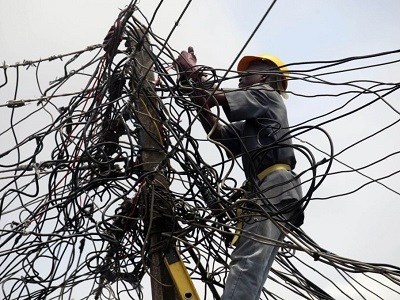 Why do I need a UPS? Why do I need a UPS?
In the June 2019 edition of the newsletter we covered power strips and surge protectors. This month's edition will go one step further and cover power conditioners and uninterruptable power supplies, (UPSs).
What is a power conditioner and what does it do?
Power conditioners are devices that “clean up” the electrical current. Normal A/C power reverses the polarity and the direction of current flow. Under ideal circumstance this forms a smooth sine wave curve. But not all sine waves are created equal. Additionally other voltage irregularities can be present in the current flow. A power conditioner eliminates these irregularities and delivers a smooth sinusoidal power flow to the devices it protects.
What is an uninterruptable power supply and what does it do?
Uninterruptable power supplies, (UPSs) are devices that provide emergency power when the main power fails. UPSs perform three primary functions:
- They condition the “dirty” power coming in much like a power conditioner.
- Provide “ride-through” power to cover for sags or short term outages.
- Provide normal electrical power to the system when the main power fails.
Since the UPS also provides power conditioning for most applications it is a good idea to go the full measure and get a UPS instead of just a power conditioner. That way you are protected not just from the “dirty” power but also a loss of power.
Different type of UPSs.
There are five main types of UPS topology:
- Standby UPSs allow equipment to run off the utility power until the UPS detects a problem. Then they switch to battery power. These are good for systems that require simple backup with less sensitive equipment.
- Line-Interactive UPSs actively regulate voltage by boosting or decreasing utility power before allowing it to pass to the protected equipment. These are a good choice when protection from power anomalies is required but utility power is relatively “clean”.
- On-Line UPSs provide the highest level of protection by isolating equipment from the utility power. They convert AC to DC and then back to AC. So the equipment is always running off the battery and the UPS is always recharging the battery. These UPSs are for mission-critical systems or where the utility power is really dirty and unreliable.
- Ferroresonant UPSs are like Line-interactive UPSs with one addition feature. A ferroresonant transformer is used to condition the output power and hold energy long enough to cover the time between switching from utility power to battery. These are no longer the dominant type of UPS but they tend to be very robust and are still used in many industrial environments.
- Multi-Mode UPSs are for customers looking for a balance of efficiency and protection. These UPSs have a high efficiency “eco-mode” and a premium power protection mode. They can switch between these modes when the UPS detects a problem with the utility power.
Additionally there are Single Phase, Three Phase and Split Phase UPSs. Utility companies generate three phase power because that is the most efficient way to transport electricity. For large power consumers it stays as three phase but for smaller consumers this is converted to single phase. The split phase is for situations where both single and three phase power is needed. They can simultaneously provide both 120 volt and 240 volt electrical power.
How big of a UPS do you need?
UPSs are rated in VA or volt-amps that range from 300 VA up to 5,000 kVA. A UPS system that can't provide enough electrical power to all the equipment attached to it is useless. So add up the wattage / voltage of everything that is going to be plugged into the system. This may sound simple but it is time-consuming. Remember that devices like motors, laser printers and medical imaging device require a much larger amount of electrical current on start-up that they do once they are operating.
It is best to get some over capacity here if for no other reason than just to be safe. Also future expansion is almost unavoidable. As a general rule get a UPS with at least fifty percent more capacity that you think you will need. Most UPS manufactures like APC, Tripp and Eaton have free on-line calculators to help you size the UPS to your needs.
 Get the right UPS for your needs! Get the right UPS for your needs!
Most UPSs have an estimate of how long they could maintain power at the current load levels. This is displayed either on a display on the UPS itself or through software and a communication link to a computer. It has been my experience that the actual time that the battery can supply power is much less than what is shown. Just another reason to get more capacity than you think you will need!
Can your equipment survive a shutdown? Most office computers, small servers and telephone systems can be shut down and rebooted with few problems. In these cases UPS systems that provide ten to fifteen minutes of power will allow you to do a controlled shutdown and the restart when the power comes back on-line.
Other systems like servers for customer access, security systems or mail servers are so mission-critical that they can never be shut down. In such cases extended battery modules may be needed. These are additional batteries that can be connected to the UPS and provide power for up to several hours.
If power failure is just not an option then you may need to consider a backup generator. In these cases the UPS only needs to maintain power until the generator gets up to speed. But not all UPSs pair well with a generator. It is important to match the UPS with the generator that you are using to make sure that frequency and voltage ranges are compatible. As with UPSs it is best to get a generator that has at least fifty percent more capacity than you think you will need.
Other considerations when planning a UPS purchase.
Rack mount or tower form factor?
While rack mount can save space you often pay a lot more for that compact form factor. Also some of the larger capacity UPSs just won't fit in a rack.
Lithium-ion battery UPSs.
Valve Regulated Lead Acid batteries have been the standard for UPSs for many years but Lithium-ion batteries are becoming more common. Lithium-ion batteries have longer life span, smaller footprint and faster recharge times. This means that Lithium-ion UPSs will save a considerable amount in operating expense over the file of the UPS.
Pure Sine Wave UPSs.
When running on the battery most UPSs produce a “modified” sine wave. While most IT equipment can, (and does) operate normally on a modified sine wave that doesn't hold true for everything. For more sensitive devices like medical imaging machines, telecommunication systems and mission critical servers a pure sine wave UPS is worth the extra cost to avoid damage and decreased efficiency.
Network capable UPSs
For a decentralized power structure UPSs with network capable monitoring isn't just a convenience. The ability to monitor and resolve issues from a central point without having to travel from site to site to can be critical in an emergency.
A Rollover UPS
It is becoming more common for businesses to employ multiple UPS systems so that if one fails the other one takes over. This can also be used to allow a stage by stage shutdown during a prolonged power failure. The most mission critical elements remain powered even as the rest of the building is allowed to shut down as the batteries drain.
Modular or Scalable UPS
These systems provide the flexibility to grow your UPS as your power needs grow. Rather than a huge upfront expense modular UPS systems allow you to “pay-as-you-grow”.
When planning and designing a UPS system always try to think towards the future. What will the needs be a year from now, two years, five years? It is prudent to plan for the worst case scenario.
A few years ago a data center in Florida survived the first four hurricanes and remained operational even though the storms took away the power, the roads and even parts of the building.
But nature wasn't done with them yet. The fifth hurricane brought enough water to cover the top of the diesel fuel tanks. That took out the backup generators and everything came to a stop. The cost of this shutdown ran into the hundreds of millions of dollars and the loss of service affected people around the world, including the website for one of my customer's business.
Five hurricanes in one year, in fact within three months may be extreme, but it can happen!
|